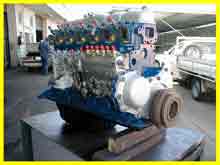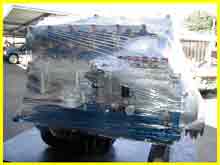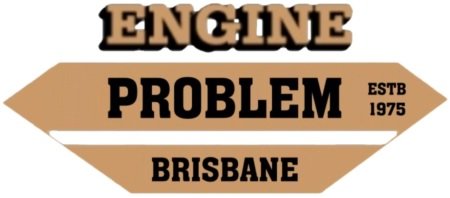Paint and Protection

Painted engine with protective plugs

Sealed & wrapped long motor
SHORT LIST OF ENGINE ASSEMBLY HINTS
ENGINE ASSEMBLY HINTS
Paint and protect from dust and water…… always paint the engine in a professional manner leaving all machined surfaces clean and free from paint. (e.g. manifold, water pump, crank snout and flywheel mounting flange,etc,etc.) **Finally seal the engine against dust and water using plastic wrap or plugs.**
Footnote: Remember that the assembled engine may sit for many weeks or even months before an initial start up.
This makes your assembly lubrication of all bearing surfaces, thrust areas, pistons, rings, pins, gears, chains, cam lobes and valve train components of utmost importance. As a general rule any good quality engine oil of correct specifications is acceptable with the additional protection of assembly lube on heavy load areas such as cam lobes and lifters.
(The assembly lubrication has to be available for use until the engine obtains full oil lubrication from the oil pump. Engines can seize or scuff bearing or load surfaces during the priming procedure if insufficient lubrication was used during assembly.)
IRRESPECTIVE OF HOW WELL YOU MAY LUBRICATE DURING ASSEMBLY DAMAGE WILL OCCUR IF THE ENGINE IS FIRED UP WITHOUT FIRSTLY GAINING OIL PRESSURE.
The safest method to obtain initial oil pressure is with the use of a pressure primer connected to the oil gallery while slowly cranking the engine. ………. The engine must never be fired up without firstly gaining oil pressure.
If the engine has been assembled with the correct clearances, correct machine finishes and assembled with the correct amount of lubricant in all of the right places it is quite safe to obtain oil pressure at cranking speed with the sparkplugs removed. It is important to keep this procedure as short as possible as excessive cranking will reduce the effectiveness of the assembly lubricant. The pre-filled oil filter should be left loose so trapped air can quickly be dispelled, re-tighten when oil pressure is obtained. Some assemblers may still experience failures using this method simply because the correct assembly procedures were not used.
(No clearance checks with insufficient vertical oil clearance, incorrect machine finishing, insufficient lubrication on assembly etc. etc.)
: Every care has been taken in writing this information and procedures, but no responsibility can be excepted for errors, omissions or misuse of this information and procedures. The information available on this site is for your instruction only and cannot be copied for sale, © copyright 2020 UMR Engines www.engineproblem.com.au
